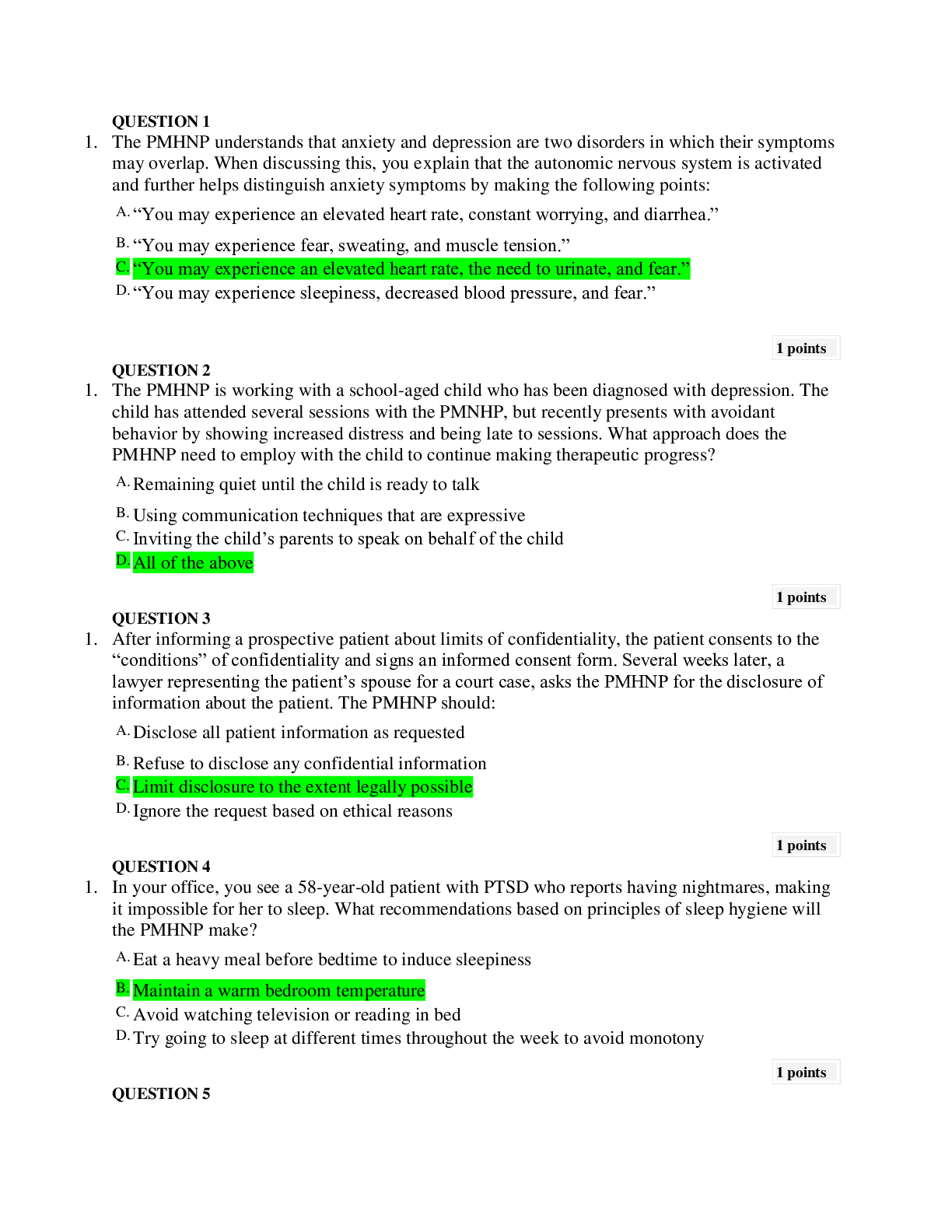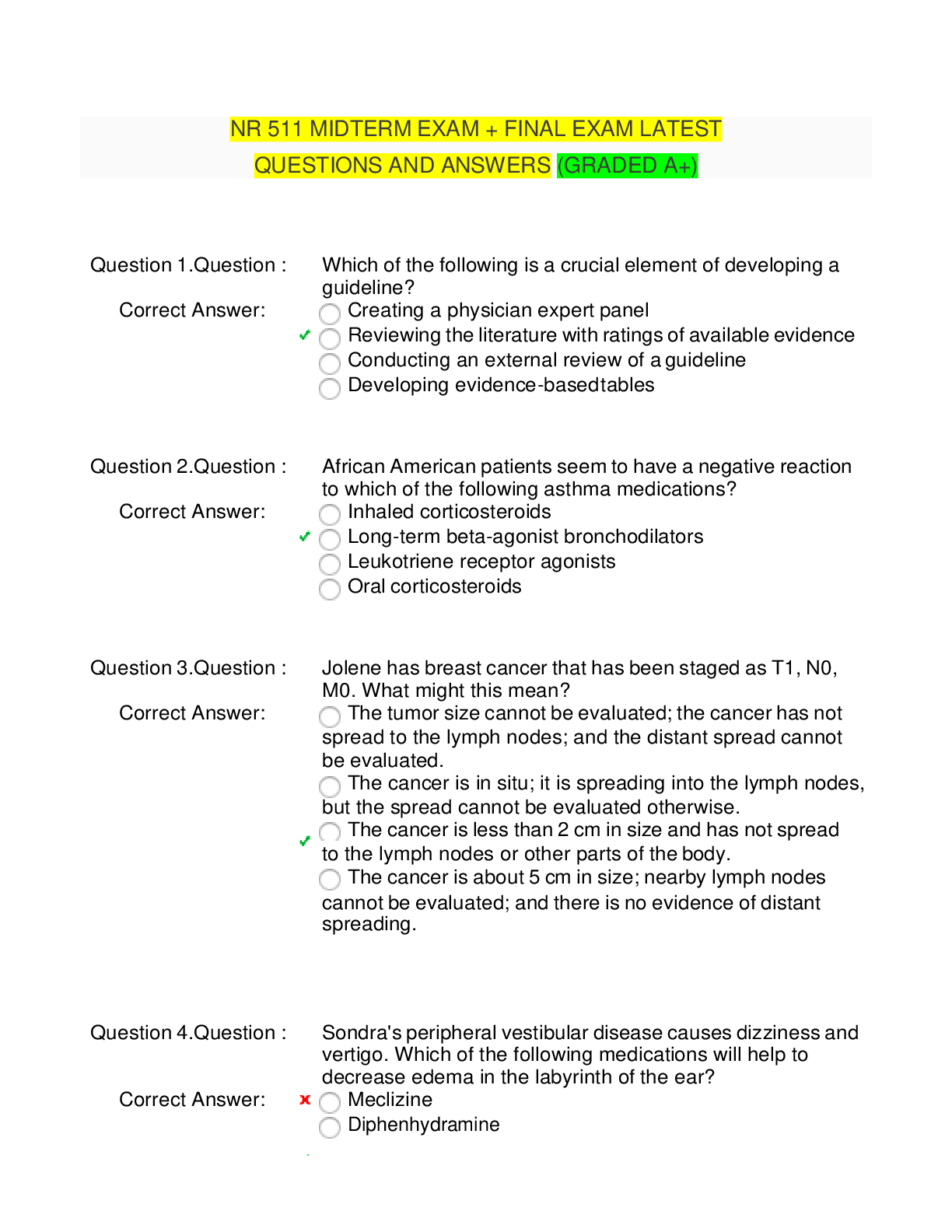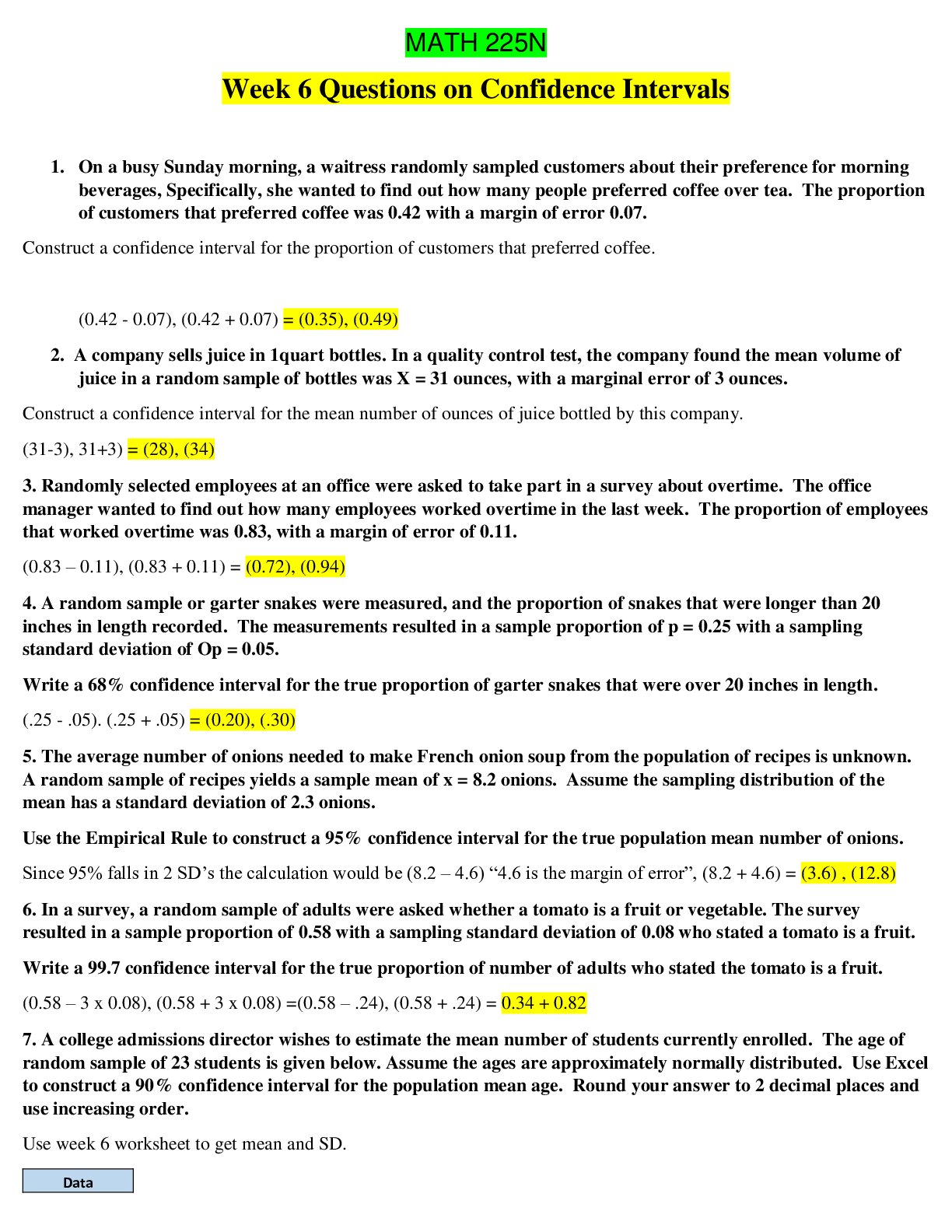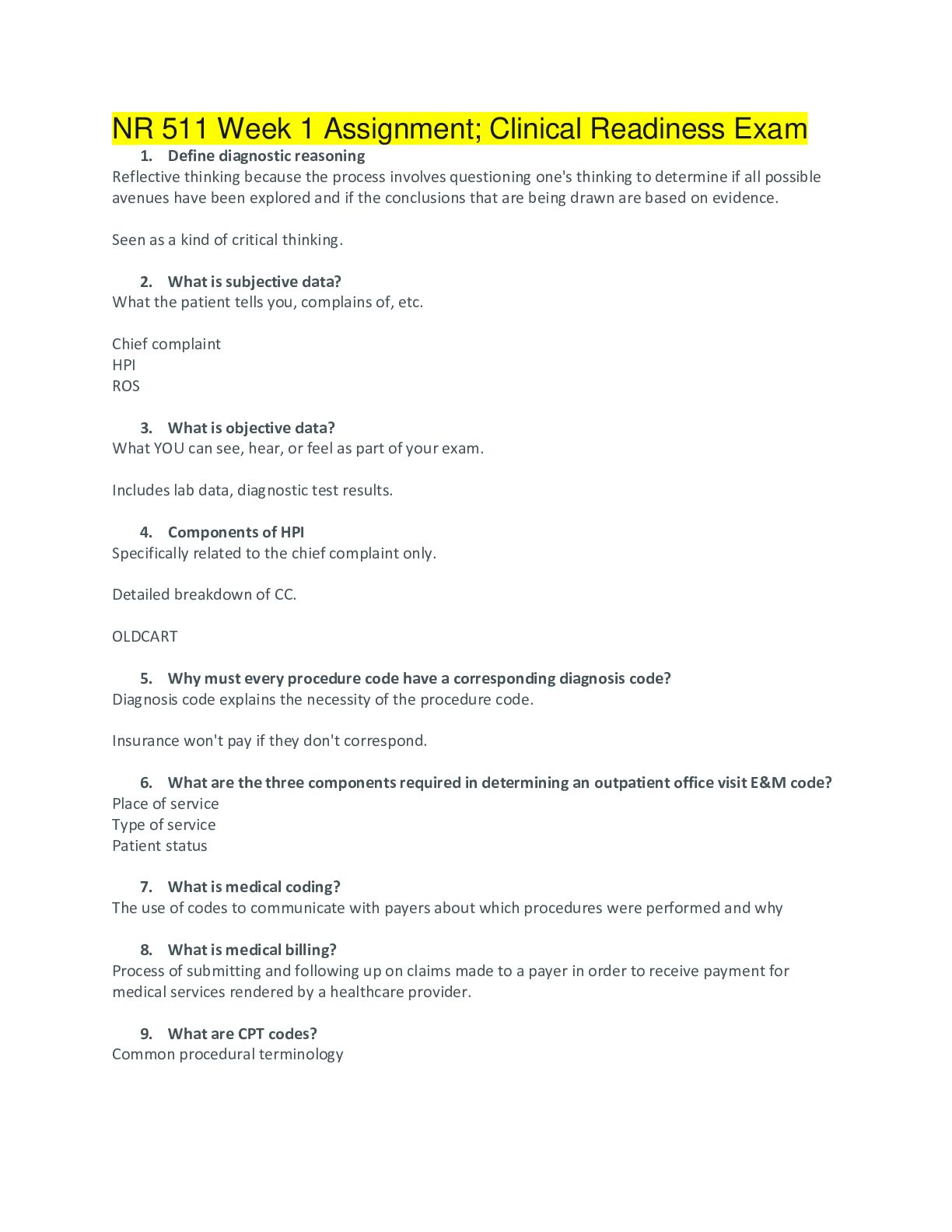Pathophysiology > EXAM > PATH 4583 Pathophysiology Week 1-TEST BANK (GRADED A) Questions and Answers solutions (All)
PATH 4583 Pathophysiology Week 1-TEST BANK (GRADED A) Questions and Answers solutions
Document Content and Description Below
PATH 4583 Pathophysiology Week 1-TEST BANK Chapter 01: Introduction to Pathophysiology Test Bank MULTIPLE CHOICE 1. Which of the following would be the most likely cause of an iatrogenic disease... ? a. An inherited disorder b. A combination of specific etiological factors c. An unwanted effect of a prescribed drug d. Prolonged exposure to toxic chemicals in the environment ANS: C REF: 6 2. The manifestations of a disease are best defined as the: a. subjective feelings of discomfort during a chronic illness. b. signs and symptoms of a disease. c. factors that precipitate an acute episode of a chronic illness. d. early indicators of the prodromal stage of infection. ANS: B REF: 6 3. The best definition of the term prognosis is the: a precipitating factors causing an acute episode. . b number of remissions to be expected during the course of a . chronic illness. c. predicted outcome or likelihood of recovery from a specific disease. d exacerbations occurring during chronic illness. . ANS: C REF: 7 4. Which of the following is considered a systemic sign of disease? a. Swelling of the knee b. Fever c. Pain in the neck d. Red rash on the face ANS: B REF: 6 5. Etiology is defined as the study of the: a. causes of a disease. b. course of a disease. c. expected complications of a disease. d. manifestations of a disease. ANS: A REF: 5 6. A type of cellular adaptation in which there is a decrease in cell size is referred to as: a. hypertrophy. b. metaplasia. c. anaplasia. d. atrophy. ANS: D REF: 8 7. A change in a tissue marked by cells that vary in size and shape and show increased mitotic figures would be called: a. metaplasia. b. atrophy. c. dysplasia. d. hypertrophy. ANS: C REF: 8 8. A deficit of oxygen in the cells usually due to respiratory or circulatory problems is called: a. apoptosis. b. ischemia. c. hypertrophy. d. necrosis. ANS: B REF: 9 9. When a group of cells in the body dies, the change is called: a. ischemia. b. gangrene. c. hypoxia. d. necrosis. ANS: D REF: 10 10. Rigorous weight lifting/body building regimens may result in the skeletal muscle cells undergoing: a. hypertrophy. b. dysplasia. c. atrophy. d. regeneration. ANS: A REF: 8 11. The term cancer refers to: a. dysplasia. b. hyperplasia. c. metaplasia. d. malignant neoplasm. ANS: D REF: 9 12. To which of the following does the term apoptosis refer? a. Increased rate of mitosis by certain cells b. Ischemic damage to cells c. Liquefaction of necrotic tissue d. Preprogrammed cell self-destruction ANS: D REF: 9 13. Which of the following statements is TRUE? a. Alteration of DNA does not change cell function. b. Damaged cells may be able to repair themselves. c. All types of cells die at the same rate. d. Mild ischemia causes immediate cell death. ANS: B REF: 10 14. Caseation necrosis refers to an area where: a. cell proteins have been denatured. b. cell are liquefied by enzymes. c. dead cells form a thick cheesy substance. d. bacterial invasion has occurred. ANS: C REF: 10 15. Routine application of sun block to skin would be an example of: a. an iatrogenic cause of cancer. b. a preventive measure. c. a precipitating factor. d. a predisposing condition. ANS: B REF: 6 16. A circumstance that causes a sudden acute episode of a chronic disease to occur is termed: a. latent stage. b. predisposing factor. c. incidence. a. the causative factors in a particular disease. b. maintenance of a stable internal environment. c. a condition that triggers an acute episode. d. a collection of signs and symptoms. ANS: B REF: 2 18. Which term is used to describe a new and secondary or additional problem that arises after the original disease has been established? a. Symptoms b. Occurrence c. Manifestations a. the structure of the human body. b. the functions of various organs in the body. c. functional or structural changes resulting from disease processes. d. various cell structures and related functions. ANS: C REF: 2 20. Which of the following is the best definition of epidemiology? a The science of tracking the occurrence and distribution of diseases . b The relative number of deaths resulting from a particular disease . c Identification of a specific disease through evaluation of signs and . symptoms d The global search for emerging diseases . ANS: A REF: 7 21. Which of the following can cause cell injury or death? 1. Hypoxia 2. Exposure to excessive cold 3. Excessive pressure on a tissue 4. Chemical toxins a. 1, 2 b. 2, 4 c. 1, 3, 4 d. 1, 2, 3, 4 ANS: D REF: 9 22. All of the following are part of the Seven Steps to Health EXCEPT: a. follow cancer screening guidelines. b. use sunblock agents whenever exposed. c. participate in strenuous exercise on a regular daily basis. d. choose high fiber, lower fat foods. ANS: C REF: 2 23. The term disease refers to: a. the period of recovery and return to a normal healthy state. b. a deviation from the normal state of health and function. c. the treatment measures used to promote recovery. d. a basic collection of signs and symptoms. ANS: B REF: 2 24. A collection of signs and symptoms, often affecting more than one organ or system, that usually occur together in response to a certain condition is referred to as a (an): a. acute disease. c. syndrome. d. manifestation. ANS: C REF: 7 25. All of the following statements are correct about cell damage EXCEPT: a The initial stage of cell damage often causes an alteration in . metabolic reactions. b If the factor causing the damage is removed quickly, the cell may . be able to recover and return to its normal state. c If the noxious factor remains for an extended period of time, the . damage becomes irreversible and the cell dies. d Initially, cell damage does not change cell metabolism, structure, . or function. ANS: D REF: 9 26. Which of the following conditions distinguishes double blind studies used in health research? Neither the members of the control group or the experimental a group nor the person administering the treatment knows who is . receiving the experimental therapy. b Both groups of research subjects and the person administering the . treatment know who is receiving the experimental therapy. c The research subjects do not know, but the person administering . the treatment knows who is receiving placebo or standard therapy. d Only members of the control group know they are receiving . standard therapy. ANS: A REF: 3 | 4 27. If the data collected from the research process confirm that the new treatment has increased effectiveness and is safe, this is called: a. the placebo effect. b. evidence-based research. c. blind research studies. d. approval for immediate distribution. ANS: B REF: 4 28. A short-term illness that develops very quickly with perhaps a high fever or severe pain is called: a. acute. b. latent. c. chronic. d. manifestation. ANS: A REF: 6 29. The term prognosis refers to the: a. period of recovery and return to a normal state. b. expected outcome of the disease. c. mortality and morbidity rates for a given population. d. typical collection of signs and symptoms. ANS: B REF: 7 30. When prolonged ischemia occurs to an area of the heart, the resulting damage is referred to as: a. atrophy. b. liquefactive necrosis. c. apoptosis. d. infarction. ANS: D REF: 10 31. During the evaluation process for a new therapys effectiveness and safety, a double blind study may be conducted during: a. the first stage. b. the second stage. c. the third stage. d. any of these stages. ANS: C REF: 3 32. Why are the predisposing factors for a specific disease important to health professionals? a. To predict the prognosis b. To determine treatments c. To develop preventive measures d. To develop morbidity statistics ANS: C REF: 3 33. Cell damage may be caused by exogenous sources such as: a. abnormal metabolic processes. b. certain food additives. c. genetic defects. d. localized hypoxia. ANS: B REF: 9 | 10 34. Which of the following is usually included in a medical history? 1. Past illnesses or surgeries 2. Current illnesses, acute and chronic 3. Prescribed medication or other treatments 4. Nonprescription drugs and herbal remedies 5. Current allergies a. 1, 3 b. 2, 4, 5 c. 1, 3, 4 d. 1, 2, 3, 4, 5 ANS: D REF: 4 | 5 35. A situation when there is a higher than expected number of cases of an infectious disease within a given area is called a/an: a. epidemic. b. exacerbation. c. morbidity. d. pandemic. ANS: A REF: 7 36. The term pathogenesis refers to: a the development of a disease or sequence of events related to . tissue changes involved in the disease process. b the determination of the cause(s) involved in the development of a . malignant neoplasm. c the specific signs and symptoms involved in the change from an . acute disease to a chronic disease. d the changes in cells of affected tissue that result in necrosis. . ANS: A REF: 6 Chapter 06: Infection Test Bank MULTIPLE CHOICE 1. Bacteria that form an irregular cluster of spheres are called: a. bacilli. c. staphylococci. d. streptococci. ANS: C REF: 89 2. A strict anaerobe requires which specific environment? a. A dry environment b. An acidic medium c. Air at a temperature less than 61 F/16 C d. The absence of oxygen ANS: D REF: 89 3. The presence of the bacterial capsule: b. protects the microbe from phagocytosis. c. increases the release of toxins and enzymes. d. prevents replication of the bacterium. ANS: B REF: 90 4. Microbial mutation means that: a. genetic information has changed. b. pathogens become nonpathogens. c. the microbe survives adverse conditions but can no longer replicate. d. the immune response to that microbe is strengthened. ANS: A REF: 101 a. also be classified as an acid-fast bacterium. b. exist in latent form inside a host cell. c. reproduce very rapidly. d. survive high temperatures and a dry environment. ANS: D REF: 96 6. The structure of a virus includes: a. a cell wall and membrane. b. metabolic enzymes for replication. c. a protein coat and either DNA or RNA. d. a slime capsule and cilia. ANS: C REF: 92 a. Binary fission b. Budding of a daughter cell from the parent viral cell c. Producing reproductive spores d. Using a host cell to produce and assemble components ANS: D REF: 92 8. A retrovirus such as HIV contains: a. RNA and enzymes for its conversion. b. a double strand of DNA. c. many enzymes to limit budding of new virions. d. numerous mitochondria. 9. How do antiviral drugs act? a. They interfere with cell wall development. b. They decrease cell membrane permeability. c. They destroy new, immature viral particles. d. They reduce the rate of viral replication. ANS: D REF: 107 10. Which statement applies to yeasts? a. They are usually considered to be pathogenic. b. They seldom contain a distinct nucleus. c. They may cause opportunistic infection in the body. ANS: C REF: 96 11. Fungi reproduce by: 1. budding. 2. extension of hyphae. 3. binary fission. 4. production of spores. a. 1, 2 b. 2, 4 c. 1, 2, 4 d. 2, 3, 4 ANS: C REF: 96 12. Which of the following is NOT classified as a protozoan agent of disease? b. Trichomonas vaginalis c. Tinea pedis d. Entamoeba histolytica ANS: C REF: 96-97 13. Which of the following is a characteristic of rickettsia? a. It is a very small gram-negative intracellular microbe. b. It exists in three forms. c. It causes sexually transmitted disease. d. It reproduces by budding. ANS: A REF: 93 a. Mosquitoes (bites) b. Inhaling contaminated particles c. Sexual intercourse d. Cysts in feces ANS: D REF: 97 15. Which of the following is a characteristic of resident or normal flora (microflora)? a. It exists in all areas of the body. b. Different species inhabit various areas of the body. c. It is of no benefit to the human host. d. It consists only of bacteria. ANS: B REF: 98 a. Urine b. Pharynx c. Distal urethra d. Vagina ANS: A REF: 99 17. The term nosocomial infection means: a. transmission involves an insect or animal host. b. acquired in a hospital or medical facility. c. transmitted by a fomite. d. spread by direct contact with secretions from an open lesion. 18. Transmission of microbes by direct contact includes: a. touching a contaminated countertop. b. sexual intercourse. c. drinking contaminated water. d. inhaling dust-borne microbes. ANS: B REF: 99 19. What does the term carrier mean? a A person with active infection who acts as a reservoir for microbes . b Animals, insects, objects, or surfaces contaminated by pathogens . c An individual who is contagious through infected secretions on the . hands d An asymptomatic person whose body harbors pathogens and can . transmit them to others ANS: D REF: 99 20. Opportunistic infection may develop when: a. pathogens enter the body but cannot colonize the site of entry. b. an imbalance occurs in the normal resident flora. c. host resistance increases, and the balance of resident flora is restored. d. contaminated food or water is unknowingly ingested. ANS: B REF: 99 21. Host resistance is promoted by all of the following EXCEPT: a. prescribed immunizations. b. chronic respiratory disease. c. vitamin and mineral supplements. d. appropriate inflammatory or immune response. ANS: B REF: 100-101 22. Which of the following factors would NOT increase the virulence of a specific microbe? a. Secretion of endotoxin b. Presence of a bacterial capsule c. Production of interferons d. Secretion of invasive enzymes ANS: C REF: 101 23. That time in the course of an infection when the infected person may experience a headache or fatigue and senses he or she is coming down with something is referred to as which of the following? a. Subclinical period b. Eclipse period c. Prodromal period d. Presymptomatic period ANS: C REF: 104 24. The principle of Universal Precautions is based on: a using disinfectants at all times to eliminate cross-infections. . b not touching any open or bleeding lesions. . c sterilizing all instruments and equipment after each use. . d assuming that all body fluids from all individuals are possible sources . of infection. ANS: D REF: 102 25. The incubation period refers to the time period between: a. entry of the pathogen into the body and the first signs of infectious disease. b. the onset of the prodromal period and the peak of the acute infection. c. the onset of clinical signs and signs of recovery from infection. d. the acute period and establishment of chronic infection. ANS: A REF: 104 26. What does bacteremia refer to? a. Numerous pathogens circulating and reproducing in the blood b. Uncontrolled sepsis throughout the body c. Multiple infections, primary and secondary, established in the body d. Microbes present in the blood ANS: D REF: 105 27. Which of the following is a local sign of infection? a. Fever and leukocytosis b. Headache and anorexia c. Pain, erythema, and swelling d. Nausea, weight loss, and fatigue ANS: C REF: 105 28. What are culture and sensitivity tests used for? b. To provide a specific medium that supports maximum microbial growth c. To identify the causative microbe and the effective antimicrobial agent for it d. To provide living host cells for microbes requiring such for replication ANS: C REF: 106 29. A broad-spectrum bactericidal agent would be expected to: a. destroy many gram-positive and gram-negative bacteria. b. destroy all pathogenic microbes in contact with the agent. c. reduce the replication of many bacteria. d. inhibit the growth of most spores and acid-fast bacteria. ANS: A REF: 107 a. It interferes with cell-wall synthesis. b. It blocks protein synthesis. c. It increases cell membrane permeability. d. It prevents DNA replication. ANS: A REF: 107 31. Secondary infection may occur with administration of antibacterial drugs because the: a. patient is allergic to the drug. b. balance of species in the resident flora is upset. c. mucosa of the stomach is irritated. d. infecting microbes spread to adjacent areas. ANS: B REF: 107-108 32. All of the following are mechanisms of antiviral drug action EXCEPT: a. interference with attachment to host cell. b. block assembly of viral particles. c. interference with mitosis. d. shedding of protein coat. ANS: C REF: 108 33. Secondary bacterial infections occur frequently during influenza epidemics primarily because: a. antiviral drugs lower host resistance. b. the virus causes extensive tissue inflammation and necrosis. d. the viral infection is usually self-limiting. ANS: B REF: 110 34. The primary pathological effect of influenza virus is: a. destruction of the mucosa in the lower respiratory tract. b. replication of the virus in respiratory secretions. c. destruction of leukocytes and macrophages in the lungs. d. inflammation and necrosis of the upper respiratory epithelium. ANS: D REF: 110 35. What does leukocytosis frequently indicate? a. Immunosuppression c. Presence of bacterial infection d. An allergic or autoimmune reaction ANS: C REF: 105 36. When an infection or inflammation is suspected, what does leucopenia often indicate? a. Bacterial infection b. Viral infection c. Allergic reaction d. Septicemia ANS: B REF: 106 37. Which of the following statements applies to Chlamydia? b. It causes a common STD. c. It possesses many flagella. d. It is excreted in feces. ANS: B REF: 93 38. Which of the following microbes is classified as an obligate intracellular parasite? a. Fungus b. Bacterium c. Virus d. Protozoa ANS: C REF: 93 39. Which of the following are characteristics of influenza virus? 1. It is an obligate intracellular parasite. 2. It contains RNA. 3. It usually causes nausea and vomiting. 4. There are three subtypes: A, B, C. a. 1, 4 b. 1, 3 c. 2, 3, 4 d. 1, 2, 4 ANS: D REF: 93 40. The widespread necrosis of respiratory mucosa caused by an influenza infection often gives rise to: a. severe anemia. b. secondary infections. c. asthma. d. emphysema. ANS: B REF: 110 41. Prions cannot be cultured in a PETRI plate of media because: a. they take so long to grow. b. they require extensive amounts of specialized nutrients. c. they are proteinaceous particles, not living organisms. d. they are viruses that don't grow on conventional media. ANS: C REF: 98 42. Which of the following statements applies to Influenza A H1N1? a. It alters human chromosomes to cause manifestations. b. It usually causes severe respiratory distress and high fever. c. Infection is common in the elderly. d. It contains genetic material from avian, swine, and human viruses. ANS: D REF: 93 43. Which of the following does NOT directly determine the virulence of a microbe? a. Capacity for opportunism b. Production of toxins c. Ability to mutate d. Invasive qualities ANS: A REF: 101 44. Which of the following is a function of interferons? a. They block the invasion of pathogenic bacteria. b. They reduce the inflammatory response to local infection. c. They increase host cell resistance to viral invasion. d. They may facilitate the spread of some cancer cells. ANS: C REF: 100 45. Inflamed tissue is likely to become infected because: a the immune system is not effective in inflamed tissue. . b the increased fluid and protein in the inflamed area supports microbial . growth. c. phagocytes cannot penetrate the inflamed areas. ANS: B REF: 105 46. When an infectious disease is occurring globally at a higher rate than usual, it may be designated as a/an: a. sporadic occurrence. b. epidemic. c. pandemic. d. emerging disease. ANS: C REF: 99 47. Which of the following is the primary difference between an antiseptic and a disinfectant? a Antiseptic is used on living tissue, whereas disinfectant is designed for . nonliving surfaces. c Antiseptic often causes allergic skin reactions, whereas disinfectant is . always hypoallergenic. d Antiseptic is effective against endospores; disinfectants are not . effective against endospores. ANS: A REF: 103-104 48. Drugs that are designed to inhibit or slow down growth of microbes but not necessarily kill them are considered: a. ineffective. b. bacteriostatic. c. narrow-spectrum. d. bactericidal. ANS: B REF: 107 [Show More]
Last updated: 1 year ago
Preview 1 out of 46 pages
Instant download

Buy this document to get the full access instantly
Instant Download Access after purchase
Add to cartInstant download
Reviews( 0 )
Document information
Connected school, study & course
About the document
Uploaded On
Jun 17, 2021
Number of pages
46
Written in
Additional information
This document has been written for:
Uploaded
Jun 17, 2021
Downloads
0
Views
41






.png)














